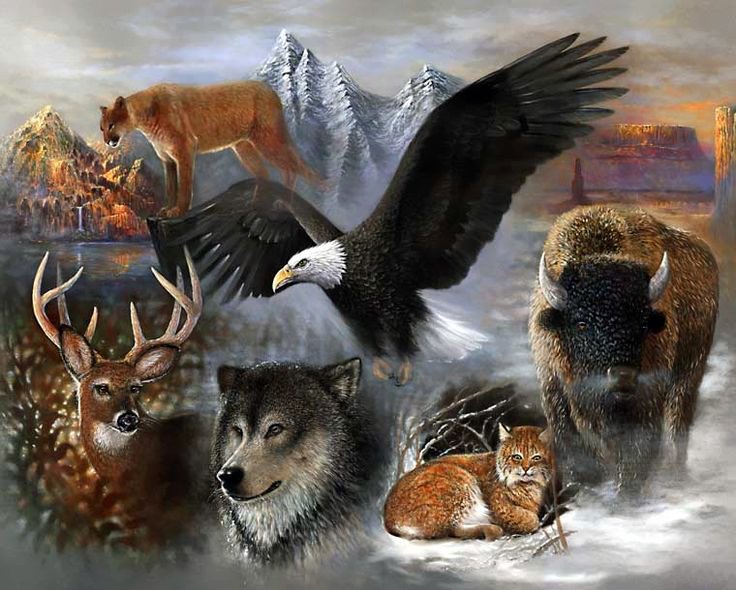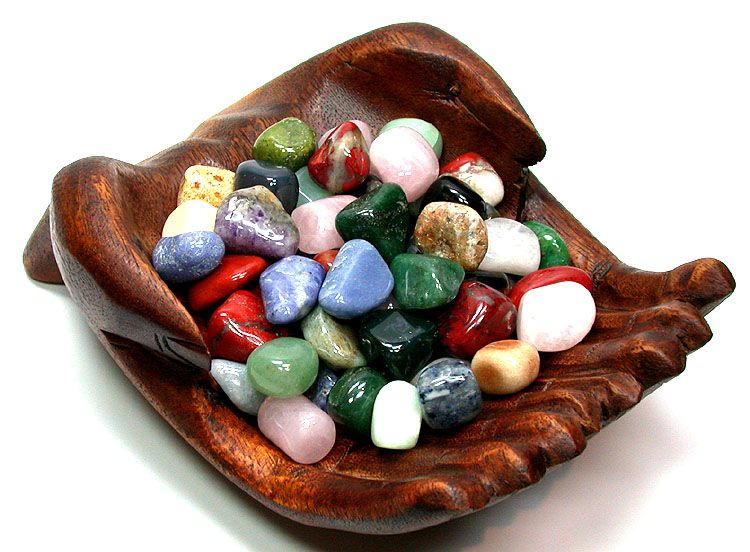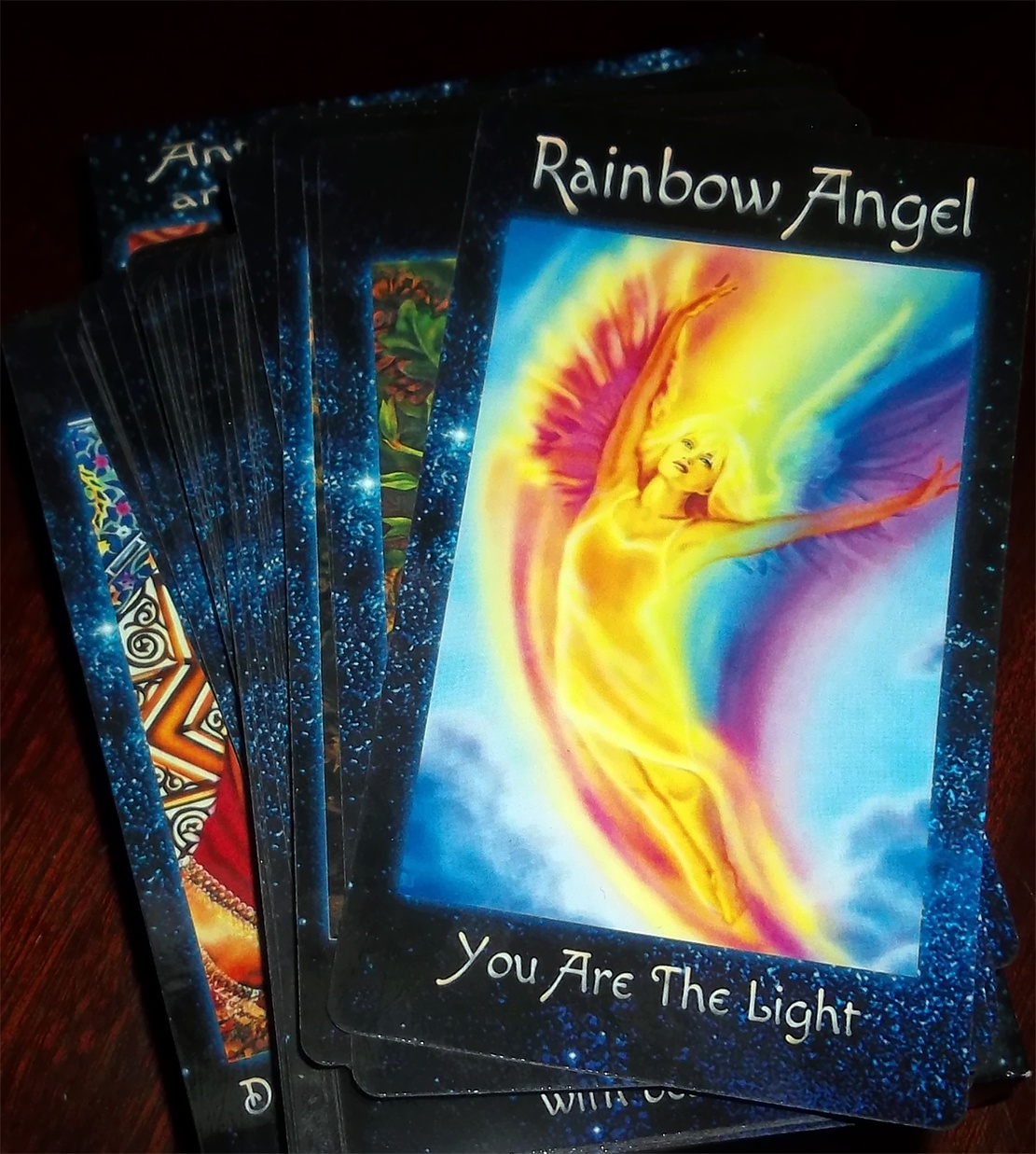Origin and Symbolism of the Crystal Skulls
- Details
- Written by AndEl
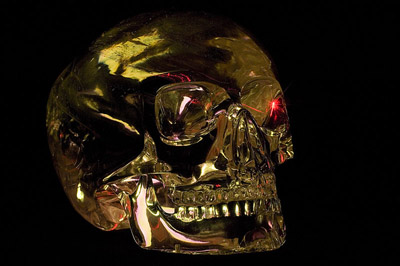
Philip Coppens
The mysterious crystal skulls are likely to have originated in Central America and may have performed an important role in re-enacting the Mayans' creation myth and networking their temple complexes.
Sacred Relics or Alien Artifacts?
Although researchers have written dozens of books and hundreds of articles about crystal skulls, few have attempted to explain the origin and purpose of these sculptures. For some, the crystal skulls are 19th-century "hoaxes"; for others, they are extraterrestrial artifacts, while yet others believe they are remnants of a lost civilization.
Perhaps the most likely explanation is that they are part and parcel of the ancient cultures, particularly the Mayan, that existed in the area of Central America where they were found. Could it be that these skulls were one of the most important relics in the sacred temple complexes? Crystal skulls speak to the imagination, but are some of these skulls and their stories too good to be true?
The English artist Damien Hirst focused his 2007 exposition "Beyond Belief" around a platinum skull completely covered by 8,601 diamonds weighing 1,106 carats. "For the Love of God" is a life-sized cast of a human skull containing a single large diamond in the middle of the forehead, reportedly worth US$4.2 million alone. Hirst financed the project himself, and estimated its cost as between £10 and £15 million (approx. US$20–US$30 million). It is the most expensive piece of contemporary art ever created. He later sold the skull to an unnamed investment group for £100 million (approx. US$200 million).
The fourth installment of the Indiana Jones movie, Indiana Jones and the Kingdom of the Crystal Skull, has Indy in a race against Soviet agents to find a crystal skull. In an early episode of the television series Stargate SG-1, a crystal skull was used as an artifact, left behind by an ancient extraterrestrial civilization, which transported people between Earth and the aliens' home world. Crystal skulls have therefore served Hollywood and the entertainment industry well. But Tinseltown's plotlines are very much copied from existing theories about crystal skulls – one of which was insured for US$500,000, and this was 30 years ago. But what are they?
The crystal skulls began their slow climb to fame in the 1980s, largely through researcher Joshua Shapiro's meeting Sandra Bowen and Nick Nocerino, who had a crystal skull named Sha-Na-Ra in their possession. Slowly, Shapiro became exposed to a number of other skulls, with names such as the Mayan Crystal Skull, the Mitchell-Hedges Crystal Skull and the Texas Crystal Skull (also known as Max, supposedly given to the people of Guatemala by a Tibetan healer).
In March 1989, Bowen, Shapiro and Nocerino's Mysteries of the Crystal Skulls Revealed was released. The book created a vehicle through which the authors were able to "meet" several more skulls, with names such as Windsong, Rainbow, Madre, Synergy and even ones named Skully and ET. ET is a smoky quartz skull found in the early 20th century in Central America. It was given its nickname because its pointed cranium and exaggerated overbite resemble those of an alien being (and the skull is somewhat similar to the alien-looking one that Indiana Jones needs to find). ET is part of the private collection of Joke (pronounced "Yo-kay") Van Dieten, who tours with her skulls to share the healing powers she believes they possess.
Today, there are dozens of crystal skulls in circulation. The majority of these are what are perhaps best called "second-generation" skulls – modern fabrications, owned or "worked" by people who use the skulls for healing, meditation, channelling, etc. But there are also a dozen or so skulls that appear to be older and from unknown provenance. These crystal skulls have largely appeared out of nowhere, often going straight into private collections. Only two skulls sit in museums – one in London, the other in Paris.
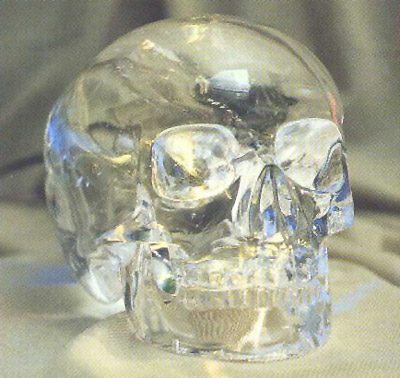
Controversy over Fabrication Claims
The British Museum Skull is part of the exhibit at the Museum of Mankind in London, where it is one of the most popular items on display. The label on its case reads "originally thought to have been Aztec, but recent research proves it to be European", of late 19th-century fabrication. The museum obtained the skull for £120 in 1897 from Tiffany & Co., the New York-based jewellers. As to how Tiffany's had acquired it, speculation was that it originated from a soldier of fortune in Mexico.
In 2004, Professor Ian Freestone, of the University of Wales at Cardiff, examined the skull and concluded that it was cut and polished with a wheeled instrument, which he said was not used by the Aztecs (see http://hnn.us/roundup/comments/9582.html). Freestone argued that the sculpture was therefore of modern, post- Columbian origin, further noting that the crystal used was common in Brazil but not Mexico – the Aztec homeland – and that "the surface of the skull, which contains tiny bubbles that glint in the light, is more sharply defined than softer-looking Aztec crystal relics with which it has been compared". However, Freestone said that even though there was strong circumstantial evidence suggesting the artefact was 19th-century European in origin, this did not amount to cast-iron proof.
In recent years, the story of how the British Museum acquired the crystal was investigated by Dr Jane MacLaren Walsh of the US Smithsonian Institution. She concluded that the British Museum Skull and the one at Musée de l'Homme (Museum of Man) in Paris were both sold by Eugène Boban. Boban was a controversial collector of pre-Columbian artifacts and an antiques dealer who ran his business in Mexico City between around 1860 and 1880. Though it is indeed likely that Boban placed the skull at Tiffany's for auction, there is no hard evidence. However, such evidence does exist for the Musée de l'Homme Crystal Skull, which in 1878 was donated by collector Alphonse Pinart who had bought it from Boban. Boban's 1881 catalogue does list another crystal skull, "in rock crystal of natural human size", selling for 3,500 French francs – the most expensive item in the catalogue. It is possible it was never sold, and hence was offered to Tiffany's to sell at auction.
Having established these facts, however, Walsh then argued that the skulls are not genuine artifacts but instead were manufactured between 1867 and 1886 in Germany, as German craftsmen were deemed to be the only people with the skills to be able to carve these skulls.
Though Boban was indeed a controversial figure, he was, of course, no different from all the other operators on the antiquities markets in those days – some of whom made deals for treasures such as the Rosetta Stone or the Elgin Marbles that continue to upset entire nations from which they were "exported".
However, there is no evidence – not even circumstantial – that Boban sourced these skulls from Germany. It is logical to conclude that, as Boban operated in Mexico, he may have acquired the skulls in Mexico. It would be completely logical to assume that, if they are Aztec in origin, they were offered on the Mexico City antiques market where Boban picked them up. It is the most logical scenario, yet academics seem to prefer the modern German fabrication theory for which there is no evidence. Why? Perhaps they prefer to label them as fakes so as to evade potential claims from Mexican authorities?
As to the fact that the skulls were polished with a wheeled instrument, Professor Freestone himself argued that this in itself does not mean they are modern fabrications (he examined the Paris as well as the London skull in 2004). Though Freestone, Walsh and others suggested this overturns the likelihood that the skulls are pre-Columbian, other experts like Professor Michael D. Coe of Yale University stated that evidence of wheel markings in no way proves that the skulls are modern. He actually said that although it has long been accepted that no pre-Columbian civilization used the rotary wheel, new evidence contradicts this scientific dogma. Wafer-thin obsidian ear-spools are now known to have been made using some rotary carving equipment and to be dated to the Aztec/Mixtec period. According to Chris Morton and Ceri Louise Thomas in The Mystery of the Crystal Skulls, Coe concluded (p. 226): "People who sit in scientific laboratories don't know the full range of the culture they're dealing with. We really don't know half as much about these early cultures as we think we do. People need to re-examine their beliefs."
Walsh and some of her colleagues have largely presented Boban as a charlatan, but they've failed to report that Boban was known to have owned genuinely ancient artifacts as well as a collection of rare books and early Mexican manuscripts. He had even written a scientific study, "Documents pour server à l'histoire du Mexique" ("Documents to serve the history of Mexico") (1891). Furthermore, he personally crusaded against frauds and fakes, such as in 1881 when he spoke out against forgeries that were being made in the suburbs of Mexico City. Would he shoot himself in the foot that same year by listing a fraudulent crystal skull in his catalogue?
Mentions of the German connection and claims of Boban's dishonesty come from a single letter from one of Boban's competitors, Wilson Wilberforce Blake. He wrote how they should buy from him, not Boban, who was "not honest", and he made accusations that the skull Boban had sold was a forgery, insinuating that the skull had been made in Germany instead. However, no evidence was ever produced for any of these claims, and it is clear that Blake had an obvious motive as to why he wanted to smear Boban's character: he was specifically after Boban's share of the market.
In short, Walsh has uncovered good indications that Boban had skulls and sold them; but as to a German connection, she has relied on the words of a man who almost openly stated that he was out to smudge Boban's ethics. As such, the story of how the crystal skulls have been treated by academics has – alas – all the usual hallmarks of how the scientific establishment treats such anomalous finds and pushes them aside, labeling them fakes. And afficionados of the genre will know that involvement of the Smithsonian Institution and the British Museum in such a controversy is not a unique event.
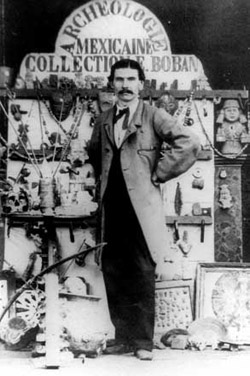
Archaeological Speculation
Eugène Boban
Could these skulls be genuine archaeological finds? As Morton and Thomas pointed out, Boban's artefacts went on sale at a time when Teotihuacán, just north of Mexico City, was being excavated. Teotihuacán is one of the most important sites in the Americas, with pyramids – and a pyramid layout – on par with the pyramids of the Giza Plateau.
Boban is known to have visited the excavations; in fact, he did so in the company of Leopoldo Batres, the Inspector of Monuments. Interestingly, Blake claimed that Batres, too, was "not only a fraud but a swindler". Even if these allegations were true, did Boban get the skull from Teotihuacán? If so, the finger of guilt should not point to Batres. In those days, half of the finds the excavators made ended up on the black market, while the other half became part of the "archaeological record". It is known that even the great Howard Carter, in his exploration of the Tutankhamun tomb – heralded as the greatest archaeological discovery of the 20th century – fell victim to this.
Either way, concluding that the skulls are genuine archaeological treasures is more logical – and better documented – than speculating about a theoretical German connection. However, it is a fact that none of the skulls was found during an archaeological excavation – that is, apart from the so-called Mitchell-Hedges Crystal Skull, named after its discoverer, the adventurer F. A. (Mike) Mitchell-Hedges, if we believe the "official" version of its find. This skull is by far the most beautiful, detailed and complex, and consists of two parts: the skull itself and a separate jawbone which allows for movement, as if the head is speaking. Famed science fiction writer Arthur C. Clarke used an image of this skull as the logo for his popular television series Arthur C. Clarke's Mysterious World.
The official version goes that the skull was found in the ruins of Lubantuun in Belize (then British Honduras) in 1924 during an archaeological survey of the site, though controversy reigns over this conclusion. This "Skull of Doom", as Mitchell-Hedges himself labeled it, was not referenced until 1931 as being in existence.
In his autobiography Danger My Ally (1954), Mitchell-Hedges stated that "the Skull of Doom is made of pure rock crystal and according to scientists it must have taken 150 years, generation after generation working all days of their lives, patiently rubbing down with sand an immense block of rock crystal until the perfect skull emerged". He continued: "It is at least 3,600 years old and according to legend was used by the High Priest of the Maya when performing esoteric rites. It is said that when he willed death with the help of the skull, death invariably followed. It has been described as the embodiment of all evil." For a man who had "danger" as his "ally", he obviously tried to frighten his readers with the power of this object.
So, Mitchell-Hedges associated the crystal skull with the Maya in 1600 BC – when the Maya were not yet around. Noting Mitchell-Hedges's interest in finding evidence for Atlantis, many people have argued that the skull is therefore a relic of this earlier civilization. What the skeptics have made of this can be easily divined...
A Crystal Legacy
Today, three main theories exist about what crystal skulls are and where they come from. One argument states that they are an extraterrestrial legacy; another that they are remnants of a lost civilization (often to be read as Atlantis), both of which are favoured on the New Age circuit. For the skeptics, they are "obviously" late-19th-century fabrications from Germany. A fourth theory, however, might be closer to the truth.
The problem of the crystal skulls is that they are made of crystal. Quartz crystal does not age; it does not corrode, erode, decay or change in any way with time. It cannot be carbon dated. A skull could be hundreds if not thousands of years old, yet still look as if it was made yesterday – and vice versa. Hence, other means of dating had to be devised, and so evidence of skulls having been polished with wheels has become the key determinant of whether they are modern/post-Columbian or "genuine" archaeological artifacts.
As mentioned, Michael Coe has scorned those laboratory scientists who have preached against the authenticity of the skulls. And rightfully so, as one skull, owned by Mexican Norma Redo, is mostly notorious, at least for some, as the skull that supports a large crucifix on its top. The skull shows similar "evidence" of wheelwork, but from his analysis archaeologist Dr Andrew Rankin argued that the skull was sculpted from the same crystal as that of the crystal goblet from tomb no. 7 at Monte Albán, which is an uncontested archaeological find. Furthermore, the 1571 hallmark on the crucifix is also deemed to be genuine, thus in general excluding the likelihood that this skull is of 19th century European fabrication. In short, this hard evidence confirms what Michael Coe has argued: that the Maya apparently do seem to have been able to work with crystal... and thus may have made the crystal skulls after all.
However, the Maya would not have been the only ancient civilization to have mastered working with crystal. Robert Temple's The Crystal Sun (2000), subtitled Rediscovering a lost technology of the ancient world, was promoted thus: "Based upon 33 years of research all over the world, in museums from Stockholm to Shanghai, from Athens to Cairo, and in thousands of books in several languages, Robert Temple has reconstructed a wholly forgotten story: the story of light technology in ancient civilization. It goes back at least to 2600 BC in Old Kingdom Egypt, and continues throughout Western antiquity."
Temple's quest began when he spoke to Arthur C. Clarke about the Mitchell-Hedges Skull, whereby British science historian Derek Price, who is most famous for his study of the Antikythera device (another anomalous archaeological discovery that only recently has received serious academic attention), then spoke to him about the Layard Lens as another example of our forefathers having worked with crystal.
In the mid-19th century, English archaeologist Sir John Layard excavated the remains of Babylon and Nineveh. In 1850, during the excavation of the throne room of the Assyrian King Sargon II's palace, he discovered a lens. It is dated to 721–705 BC and is currently – also – in the British Museum. It is considered to be the first used (or found) plano-convex lens.
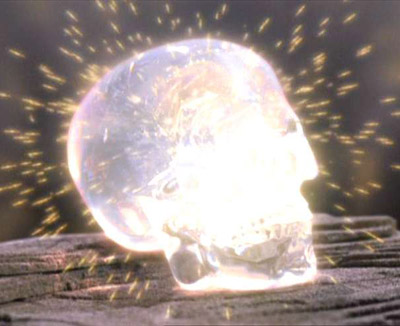
Temple notes on his website: "...this rock crystal lens, now cracked and considerably damaged, was originally a perfect convex lens with a flat ('plane') base, which was ground in a special way known to opticians as 'toroidal' – a technique only available for the public since about 1900. Such grinding produces lenses to correct for individual cases of astigmatism. It would be possible to go out into the street today and find someone whose astigmatism was perfectly corrected by the Layard Lens... It is most extraordinary that such a high technology existed in the 8th century BC. And not a single Assyriologist has acknowledged the publication of my study of this important object except for the one who encouraged me in the first place; he was curious as to what the results would be. So it appears that the community of Assyriologists find it convenient not to 'see' my book."
Why? Largely because, as with the crystal skulls, the establishment believes – for that is what it is – that only from the 19th century were "we" able to do such things.
However, archaeologists are not totally denying the existence of lenses in antiquity, as evidenced in a study by George Sines and Yannis A. Sakellarakis (American Journal of Archaeology, vol. 91, no. 2, April 1987), reporting how "...a recent find in the Idaean Cave in Crete of two rock crystal lenses of unusually good optical quality led to this investigation of other lenses from antiquity. The evidence indicates that the use of lenses was widespread throughout the Middle East and the Mediterranean basin over several millennia." They added: "The use of lenses as burning glasses in Classical Greece is noted, as is the need for magnifying lenses to authenticate seal impressions."
Scientific Scrutiny of the "Skull of Doom"
Mike Mitchell-Hedges
In 1936, eminent anthropologist G. M. Morant and Adrian Digby, a future Keeper of the Department of Ethnology at the British Museum, analyzed the Mitchell-Hedges Skull and argued that it is not of modern workmanship. Digby wrote: "...in neither case [they analyzed the British Museum Skull as well] is there any trace of identifiable tool marks, and it is certain that neither specimen was made with steel tools. On the teeth there is no trace of a lapidary's wheel which would betray one or both specimens as being of comparatively recent origin." Writing in the journal Man in July 1936 (vol. 36), they both commented that the skull's detachable lower jaw would have taken the creator – whoever he was – many hundreds if not thousands of hours of extra work, and that thus there would have to have been an important reason why the jaw had to be detached – more so than for purely artistic reasons. In 1964, Anna "Sammy" Mitchell-Hedges – the adventurer's adopted daughter and custodian of the Skull of Doom – lent the skull to Frank and Mabel Dorland, famous art experts and restorers. Dorland commenced his study by taking many photographs from various angles. He also used a binocular microscope to create a three-dimensional image of the skull.
During this scientific analysis, the skull also seemed to reveal a magical dimension. One evening, Dorland finished his work too late for the skull to be returned to its vault in the Mill Valley Bank. So he took the skull home, placing it next to the fire he had lit for the evening. He then noticed how the light of the fire was reflected through the eyes of the skull. This made him realize that the skull allowed certain optical effects to be produced – though other stories state that throughout the entire evening the house was also a hive of poltergeist activity.
Dorland discovered that the optical effects were the result of how the skull had been carved, which gave him even further insights into the precision of the workmanship. He observed that there was a type of "layering" on top of the skull, which made the skull behave like an amplifying glass. The back of the skull channelled the light through the eye sockets at the front of the head. While no one would be able to see what was happening from behind the skull, anyone looking at the face would perceive a spectacular series of images that would appear to come from within the skull itself.
Finally, Dorland discovered two holes at the bottom of the skull that are invisible when the skull is positioned upright. The holes can be used so that the skull can be swung without falling over. Together with the detachable jaw, this was a further indication that this skull was not a mere display object but had been created to perform certain functions: to move, if not pretend to speak (via the detachable jaw), and to "project" certain images to the observer standing in front of it.
In December 1970, Dorland took the skull to the laboratories of Hewlett-Packard in Santa Clara, California, at the time one of the world's most advanced centres for computers and electronics. The lab technicians were specialists in the production of precision quartz crystals, which were used in various high-tech instruments. It meant that they were perfectly suited for trying to figure out how the skull could have been made.
One test revealed that the skull was made out of one piece of quartz, with the separate jawbone coming from the same piece. The lab technicians stated that they were unable to create a skull like that with the technology available to them in 1970. Their analysis showed that the skull exhibited three different types of workmanship, and hence they suggested that work on it was carried out over three generations, or a period of 60 to 70 years – about half the time Mitchell-Hedges argued it would have taken to make: 70 versus 150 years, a small difference nevertheless.
That three generations would have worked, day in, day out, on creating one skull was an unlikely scenario, and thus the skull was proposed to have been created with "unknown technology" – which soon became interpreted as being of alien origin or from a previous civilization that was technologically superior to ours, which quickly got linked with Atlantis. This was, of course, what Mitchell-Hedges had always claimed: that this skull was physical evidence of a lost, advanced civilization.
Larry LaBarre was one of the testers at Hewlett-Packard and a decade after the 1970 tests he added to his previous observations: namely, that the quartz is very hard, measuring nine out of a possible 10 on Moh's scale, meaning that only a diamond would be able to cut it. The quartz, though of one piece, was furthermore composed of three or four growth phases, each with a different axis. Cutting it would have been extremely difficult, as hitting upon a new axis might shatter the crystal if the cutter was not careful. (This is one of the main reasons why larger diamonds are more valuable; it is not solely the stone but the workmanship involved that makes large diamonds expensive.)
As for the origin of the quartz, LaBarre suggested Calaveras County in California. However, gem expert Allan Jobbins, who researched the skulls for the Arthur C. Clarke's Mysterious World TV program, thought the likely origin of the crystal was Brazil.
Skull Visions and Mayan Symbolism
Mike Mitchell-Hedges on one of his expeditions into the Mayan heartland
In recent years, controversy has raged around the creation of the skulls. With unknown provenances for them all, there are legitimate questions to pose. One of the problems is that if they are archaeological treasures, their purpose seems difficult to ascertain. Indeed, archaeologists have failed to look towards the crystal skulls as items of archaeological interest, and hence this blank canvas has been used by many people to put forward their own speculations, some more outlandish than others.
As noted, Mitchell-Hedges believed that if a Mayan priest held the "Skull of Doom" while killing someone in his thoughts, that person would die. He also believed that, equally, those not convinced of the power of the skull would die. Anna Mitchell- Hedges said that the skull "spoke" to her.
In recent times, many people have used the skulls for scrying, or visual meditation sessions. Many have reported visions, often scenes from an ancient or foreign civilization. The scenes witnessed vary strikingly, however. Some people have reported observing scenes from Mayan history, while others have reported receiving knowledge from Atlantis.
Such landscapes might actually be due to the technological aptitude of its creator(s). Frank Dorland noted the presence of two prisms within the crystal. He argued that the artist made full use of this and that the skull was therefore perfectly suited for oracular utterances. He made a series of photographs looking into the skull; these were able to capture the series of "visions" that others have had. In some, he distinguished truncated pyramids; in others, a structure like the US Capitol Building, which has a contemporary equivalent in Chichén Itzá in the Caracol; while in still other images, several little skull shapes manifested themselves. Dorland added that these images only materialized when looking through the right eye socket and that no such shapes could be seen when staring into the left eye socket.
Such information, however interesting, does not provide any firm evidence of the crystal skull's true purpose. For this, we need a clear frame of reference – and this has to be the Mayan civilization, which existed until a mere four centuries before these skulls were discovered in Mexico.
One proposition came from American archaeologist Professor Sylvanus G. Morley, who argued that within the Mayan world the skull was the symbol for the number 10: "the head-variant for 10 is the death's head, or skull, and in forming the head-variants for the numbers from 14 to 19 inclusive, the fleshless lower jaw of the death's head was the part used to represent the value of 10 in these composite heads for the six higher numbers".
Though once again interesting, this proposition does not bring us any closer to an understanding as to the skull's real purpose. However, it does show that in the Mayan world the symbology of the skull was indeed important. There are stone skulls throughout the ancient Mayan kingdom. One such skull stands at the Temple of the Inscriptions in Palenque and another in Tikal. Both skulls are carved at the top of a row of steps leading into a room that seems to have been a shrine. A stone skull is also found at the entrance to the cave beneath the Pyramid of the Sun in Teotihuacán. But most skulls are to be found on the Tzompantli ("Platform/Place of Skulls"), one of the most famous of which is at Chichén Itzá.
The Skull in Mayan Creation Mythology
Platform of the Skull, Chichen Itza
That the skulls were discovered in the Mayan heartland is evidence which accords with the few facts that we know of their provenance. The Mayan Skull and the Amethyst Skull were allegedly found in Guatemala early in the 20th century. The Amethyst Skull is made of purple quartz and the Mayan Skull is clear, but the two are otherwise very alike. Like the Mitchell- Hedges Skull, both were studied at Hewlett-Packard and they, too, were found to be cut against the axis of the crystal, making the craftsmanship all the more difficult and the crystal all the more likely to crack or shatter during the fashioning process.
Of more direct relevance is that Nick Nocerino claims that he met a shaman in 1949 while travelling in Mexico. The shaman led him to a Mayan priest who said he was authorized to sell crystal skulls because the village needed money for food. Nocerino didn't buy them, but he did study them. However, it was clear that someone was putting these skulls on sale in Central America. What happened then had happened before, and entire Mayan villages are known to have been "financially supported" by the sale of archaeological goods that at one point they had placed on the black market. With all that on offer, why would Boban need to source a German crystal skull, pay for it and then actually have great difficulty selling it?
Thus there is one likely and logical conclusion, which is that the skulls came from somewhere in Central America. It suggests that these skulls were acquired by certain people through "some" means that did not see the light of day, and that some time later they ended up at auction, the traceability of their origin largely erased.
But if they are of Central American origin, what purpose did the skulls serve, assuming they are archaeological treasures? It is a fact that all the sacred centres, including Lubantuun where Mitchell-Hedges allegedly discovered his crystal skull, had a Tzompantli which formed part of the sacred layout of the temple complex, which itself was a three-dimensional rendering of the Mayan creation myth.
This myth states that when playing ball, the twin maize gods disturbed the lords of Xibalba, the Mayan underworld. The Xibalbans summoned the two maize gods to the underworld to answer for their disrespectful behaviour, where they were subjected to a series of trials. When they failed these tests, they were killed and buried in the ball court of Xibalba. The elder twin was decapitated, and his head was hung in the tree next to the ball court as a warning to anyone who might repeat their offence. Later, and despite this warning, the daughter of a Xibalban lord went to visit the skull, which spoke to her, spitting in her hand and thus making her pregnant.
The site where the skull was hung was the Tzompantli, and in sites such as Chichén Itzá it is still a clearly identifiable part of the temple complex.
One of the tasks of the Mayan high priests was, of course, to "perform" the creation myth. The skull in Mayan mythology was linked with the hero's death, but also with rebirth. It is therefore intriguing to note that the explanation of the crystal skull serving as part of the Mayan creation myth does conform roughly with Mitchell-Hedges's interpretation of the skull's use.
This creation story has clear parallels with the technical capabilities of the Mitchell-Hedges Crystal Skull. A skull made of crystal would indeed leave the impression that this was the skull of a deity, not of a mere mortal. It should be noted that the Mitchell-Hedges Skull has no suture marks on the pate. Though experts agree that adding such an effect to the skull would have been very easy to do, the absence of such marks has several connotations. It suggests the skull, though human looking, is not that of an ordinary being. It suggests that the skull's "owner" either was born as an adult or/and was somehow a divinity, a perfect being. Furthermore, the detachable jaw would have allowed the skull to "speak", as the hero's skull is known to have done in the creation myth. Noting that the skull in this myth spat, the Mayans might have engineered that effect, too, through the use of the movable jaw that the Mitchell-Hedges Skull possesses.
Dorland demonstrated that, in order to give it the illusion of speaking, the skull could be moved by using the two holes in its base. A rod, thrust up through another hole in the altar and into the larger hole in the base of the skull, would provide the means whereby motion could be given to the crystal. The smaller hole in the skull's base would serve as the receiver for a pivot point on which the skull would move. The skull's ability to portray images would furthermore have helped the person standing in front of it to have visions or at least be able to dream away...
A New Era and the "Gathering of the Skulls"
This brings us to another often overlooked question which few people have asked: why crystal? As already mentioned, crystal skulls are now frequently used for scrying, and the use of crystal balls in mediaeval Europe was very similar to the modern use of crystal skulls in the New Age community. However, within a Mayan framework, we can go much further.
Part of the Mayan creation myth was the lighting of a New Fire, in a so-called New Fire Ceremony which also signaled the start of a new era. The New Fire, made by the gods, was a key aspect of the "esoteric rites" – to quote Mitchell-Hedges.
Today, this type of ceremony is best known in the lighting of the Olympic Flame which occurs in the run-up to a new era – the Olympiad – in the Greek temple of Olympia. Here, 11 women, playing the roles of the priestesses who were originally responsible for keeping the temple's sacred fires alight, perform a ceremony in which the torch is kindled by the light of the Sun, its rays concentrated by a parabolic mirror. As already noted, lenses were used in antiquity to concentrate light. In Greece, fire had divine connotations, and legends state that it had been stolen from the god Zeus by Prometheus. But Greece was but one of dozens of civilizations, whether in the Old or the New World, in which fire played an important and sacred role. The Mayan civilization was another.
It is therefore of great interest to know that the Mitchell-Hedges Skull is able to start a fire if the Sun's rays fall at a particular angle on the back of the skull. Visually, it would mean that the bright sunlight coming out of the nose, mouth and eyes would start a fire, very much like the sacred fire in Olympia. Rather than use a parabolic mirror, did the ancient Mayans use a crystal skull to light the New Fire, the core ingredient that marked the start of a new era?
If this interpretation is the correct one, then there would have been one skull per religious site. This would make them very rare – but we already know that these skulls are indeed extremely rare. Though at present there is no hard evidence to prove it, this theory has the advantage of fitting with all the available evidence – unlike some more "academic" theories. If correct, it does make the crystal skulls powerful symbols: the residence of gods. And it is perhaps not a coincidence that the crystal from which the Mitchell-Hedges Skull was made is the same material used in modern technological appliances to store information.
It is clear that some of the "psychic communications" between some people and the skulls make for "extravagant" and at best unlikely claims. Sceptics have had a field day with tales of how the skulls are of alien origin, perhaps from such star systems as the Pleiades or Orion, and claims that they may be hundreds of thousands of years old.
But someone listening to a record with a broken needle will hear a very distorted communication. He is likely to conclude that the needle needs replacing and that this will thus allow him to hear the record correctly. In the case of the crystal skulls – made out of a material that is known to be able to store information and to be an electrical conduit – could it be that we have the record but we are still in search of the correct record-player?
For their book, Morton and Thomas interviewed several North, Central and South American Indians. Time and again, the authors were confronted with stories of how these crystal skulls are important. They were told that the Maya had a total of 13 such skulls – 13 being an important number for them and, interestingly, derived from the number of joints in the human body (ankles, knees, hips, wrists, elbows, shoulders, neck). We can only speculate on whether there were 13 primary temple complexes in the Mayan world, that each had a crystal skull, and that somehow these skulls formed a network. Either way, the Native Americans argue that these 13 skulls should be reunited, with 12 skulls in a circle and a 13th in the centre. Though this imagery has become very popular within the New Age community as a "Gathering of the Skulls", believed to signal a New Age of Enlightenment, it may be nothing more – or less – than the Native Americans remembering their common heritage and what the crystal skulls originally represented.
This article appeared in Nexus Magazine, Volume 15, Number 3 (April - May 2008). An earlier version of this article, with many differences, appeared in Frontier Magazine 1.3 (1995).
Liked this article? Dive deeper into personal growth and wellness! Check out CrystalWind.ca for spiritual wisdom or explore AromaWorx.ca for natural well-being tips. Spread the positivity—share this with friends on their happiness journey!
Let’s Chat! Drop Your Thoughts Below! ![]()
Dive into the Mystical World of the Crystal Wind Oracle Deck!
Get All the Enchanting Details Now!
NEW Expanded Boxed Edition!
Now with 58 Cards for Richer Wisdom!

Crystal Healing
Imagine a world of inspiration and healing, free for all—made possible by YOU!
Donate Now—Ignite the Magic at CrystalWind.ca!

Epilepsy - Finding A Cure
Your donation can make a difference!
Help us find a cure – donate now!
Crystals In Depth
Crystal Tools
Unlock Your Light: Join Lightworkers Worldwide on CrystalWind.ca!
Crystal Skulls
Follow Us!
Featured This Month
Mabon Magic: Ideas For Fall Decoration And R…
Welcome (almost!) to Fall! We’re turning the Great Wheel once again, toward ... Read more
Libra’s Featured Stone - Kyanite
Kyanite Birthstone: Libra Planet: Venus Element: Air Chakra: Throat Read more
Black Tourmaline
The Negativity Remedy Stone Black Tourmaline (Schorl) is one of the best st... Read more
Autumn Equinox
The Autumn Equinox is a time of harvesting and preparation. It is a time to ... Read more
Ducks Fly Moon
Raven - Bloodstone Jasper - Mullein - Brown September 23 to October 23 The D... Read more
Mabon in Modern Times: Fresh Takes on the Au…
The Mabon season begins somewhere around the 21st-22nd of September and cont... Read more


































































































